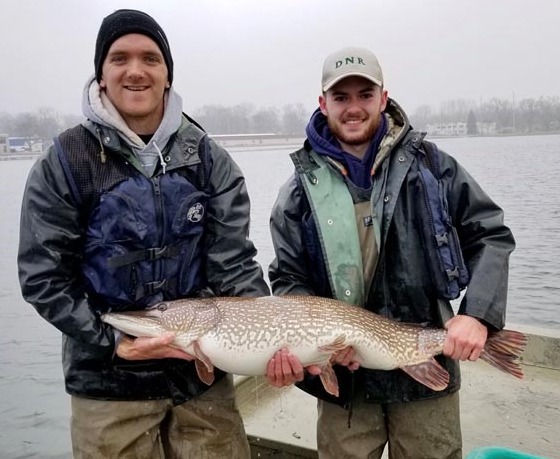
Overview
Northern pike (Esox lucius; hereafter referred to as pike) are a circumpolar species native to North America and Eurasia. Indiana represents the southernmost extent of their natural range, where they inhabit approximately one-third of Indiana’s 452 northern glacial lakes. Pike also exist in many of Indiana’s northern rivers including the Iroquois, Kankakee, Tippecanoe, Yellow, Fawn, Pigeon, Elkhart, St. Joseph, Wabash, and Mississinewa rivers. Pike are voracious predators that grow rapidly. The Indiana state record pike is 30 pounds, 2 ounces (48¼ inches), caught at Clear Lake (Steuben County) in 1992 by Jack Barnes.
Habitat
The primary habitat requirements of pike include year-round access to cool-water habitat (≤73°F and ≥3.0 parts per million dissolved oxygen) and suitable spawning habitat. Pike are one of the earliest fish species to begin spawning, often making migrations into shallow spawning grounds immediately after the ice-off on natural lakes.
The preferred spawning habitat for pike is seasonally flooded wetlands and permanently submerged aquatic vegetation. Recently hatched pike will use these shallow vegetated areas for food and protection from predators. After the spawning period, adult pike will progressively migrate deeper in the water column in search of cool-water as spring and summer surface temperatures warm the water.
Population Status
Each year, Indiana DNR’s fisheries biologists complete general fish community surveys at a series of randomly selected natural lakes. From 2010-2019, pike have been detected in approximately one-third of these surveys. Fisheries biologists also complete surveys designed specifically to target pike during the spring. These targeted surveys have shown that most pike populations comprise primarily individuals measuring between 21-28 inches, which are largely male (85%). Conversely, 72% of the pike larger than 28 inches have been females.
Table 1. Targeted pike survey catch-per-net lift at 22 northern Indiana glacial lakes since 2012. Effort for each targeted pike survey consists of eight large trap net lifts. Size categories include stock (14-21 inches), quality (21-28 inches), preferred (28-34 inches) and memorable (34+ inches) sizes.
| Lake | County | Year | Catch per net lift | <Stock | Stock | Quality | Preferred | Memorable |
|---|---|---|---|---|---|---|---|---|
| Round | Steuben | 2012 | 2.3 | 14 | 2 | 2 | ||
| Clear | Steuben | 2012 | 4.1 | 1 | 1 | 22 | 6 | 3 |
| Hamilton | Steuben | 2012 | 27.3 | 22 | 176 | 20 | ||
| Snow | Steuben | 2013 | 1.6 | 5 | 6 | 2 | ||
| Winona | Kosciusko | 2014 | 12.8 | 73 | 21 | 8 | ||
| Pike | Kosciusko | 2014 | 9.9 | 1 | 6 | 12 | 11 | 1 |
| Little Chapman | Kosciusko | 2015 | 7.8 | 46 | 14 | 2 | ||
| Jimmerson | Steuben | 2015 | 0.9 | 1 | 2 | 2 | 2 | |
| Crooked | Steuben | 2016 | 1.4 | 8 | 1 | 2 | ||
| Syracuse* | Kosciusko | 2016 | 1.9 | 6 | 16 | 7 | 1 | |
| Wawasee* | Kosciusko | 2016 | 1.8 | 6 | 19 | 3 | ||
| Lawrence | Marshall | 2017 | 2.6 | 1 | 11 | 7 | 2 | |
| Myers | Marshall | 2017 | 1.0 | 3 | 4 | 1 | ||
| Waldron | Noble | 2017 | 2.5 | 1 | 10 | 8 | 1 | |
| Dewart | Kosciusko | 2018 | 3.3 | 5 | 18 | 3 | ||
| James | Steuben | 2018 | 0.0 | |||||
| Loon | Steuben | 2018 | 2.3 | 1 | 8 | 7 | 2 | |
| South Twin | LaGrange | 2019 | 0.0 | |||||
| Diamond | Noble | 2019 | 1.1 | 8 | 1 | |||
| Silver | Steuben | 2019 | 0.8 | 1 | 2 | 2 | 1 | |
| Wolf | Lake | 2020 | 5.8 | 18 | 26 | 2 | ||
| Center | Kosciusko | 2020 | 0.8 | 2 | 1 | 1 | 2 |
*Effort was increased to 16 large trap net lifts.
Management
Pike are regulated under a statewide three fish bag limit and a 24-inch minimum size limit. Hamilton Lake (Steuben County) has a six fish daily bag limit and no minimum size limit (no more than 1 per day more than 30 inches). The protection and enhancement of pike populations largely hinges on the availability of habitat, including cool-water (≤73°F and ≥3.0 parts per million dissolved oxygen) and suitable spawning habitat. Anthropogenic habitat modifications (i.e., residential development, vegetation management) are believed to be a contributing factor to the eutrophication (i.e., nutrient loading) of lakes and the resulting reduction in year-round access to cool water. In order to protect pike populations, 22 cool-water glacial lake catchments were selected as Conservation Opportunity Areas (COA) in the 2015 State Wildlife Action Plan (SWAP).
State Record Fish and Fish of the Year
Indiana DNR sponsors two award programs recognizing outstanding catches by sport anglers. The Indiana Record Fish program recognizes new state record catches. The Fish of the Year program recognizes anglers who catch the largest fish of each species for that year. Weight is the measurement used for state record fish. Total length is the measurement used for Fish of the Year. Those interested in submitting entries to these programs can learn more about the programs at the Indiana Record Fish Program website.
Click on the photos below to learn more about these Record Fish and Fish of the Year entries.
Resources
Northern Pike Biologist Contact Information
Matthew D. Linn
Fisheries Research Biologist
Indiana Department of Natural Resources
1353 South Governors Drive
Columbia City, IN 46725
260-244-6805
mlinn@dnr.IN.gov
